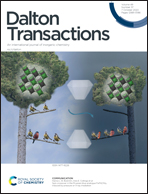Regulating the electronic structure of CoMoO4 microrod by phosphorus doping: an efficient electrocatalyst for the hydrogen evolution reaction†
Abstract
It is of extreme importance to design efficient electrocatalysts for hydrogen evolution reaction (HER), which is considered as a promising approach to provide efficient and renewable clean fuel (hydrogen). Tuning the electronic structure through heteroatom doping demonstrates one of the most effective strategies to promote the electrocatalytic performance of HER. Herein, phosphorus-doping modulation is utilized to fabricate monoclinic P-CoMoO4 with optimized electron structure supported on nickel foam (P-CoMoO4/NF) for alkaline HER via a facile hydrothermal method, followed by low-temperature phosphidation. Notably, P-CoMoO4/NF shows outstanding electrocatalytic performance for HER in 1 M KOH with a low overpotential of 89 mV at 10 mA cm−2, a remarkable Tafel slope value of 59 mV dec−1, and excellent 24 h-long stability. The excellent catalyst activity and stability merits of P-CoMoO4/NF are comparable to the reported highly efficient non-precious metal HER electrocatalysts and could be applied as a powerful electrocatalyst in water electrolysis. This work provides a superior synthesis strategy for the effective design and rational fabrication of low-cost, highly active, and highly stable non-precious metal HER electrocatalysts for electricity-to-hydrogen applications.



 Please wait while we load your content...
Please wait while we load your content...